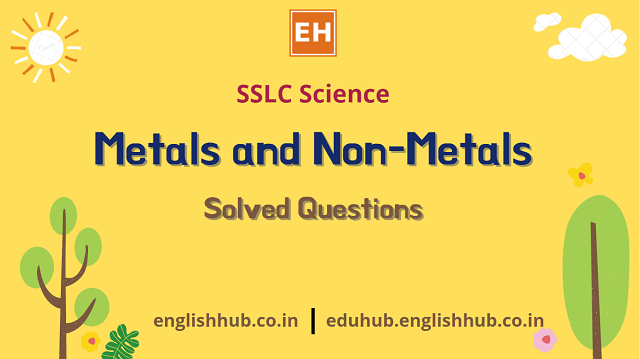Metals and Non-Metals | Solved Questions:
SSLC Science Solved Questions/Model Questions and Answers (Q&A) on the lesson Metals and Non-Metals for the SSLC English medium students have been updated in this post below. The students of SSLC can make use of this Online Study Package to get good scores in the SSLC examinations.
Teachers also can help the students to access this platform to use this FREE Online Study Package anywhere and any time.
Metals and Non-Metals
One Marks Questions
Answer: Metals in their pure state have a shining surface.
Answer: Metals can be beaten into thin sheets.
Answer: Metals drawn into thin wires.
Answer: Silver and copper
Answer: Polyvinyl Chloride
Answer: Bromine
Answer: Carbon, Sulphur, Oxygen, Iodine etc.
Answer: Mercury
Answer: Iodine
Answer: Sodium
Answer: Diamond
Answer: Sodium
Sodium is a highly reactive metal, kept open it will react with oxygen in the air.
Answer: 3 Fe(s) + 4 H2O → Fe3O4 (s)+ 4H2
Answer: The elements or compounds which occur naturally in the earth's crust.
Answer: Silver reacts with Sulphur in the air to form silver sulphide
Answer: Carbon (about 0.05 %)
Answer: amalgam
Two Marks Questions
Answer:
Some metal oxide react with both acids and bases to produce salt and water are known as
amphoteric oxides.
example:
Al2O3 + 6HCl → 2AlCl3 + 3H2O
Answer:
a) Because metals are sonorous
b) Copper is a good conductor of electricity
Answer:
2Na + 2 H2O → 2NaOH + H2 (g)
X is sodium, Y is sodium hydroxide, Z is hydrogen gas.
Answer:
Corrosion is a process in which metals react with substances present in the
environment to form surface compounds.
prevention methods:
galvanization, electroplating, the concentration of ore, electrolytic refining
Answer:
Al2O3 + 6 HCl → 2AlCl3 + 3H2O
Al2O3 + 2 NaOH → 2NaAlO2 + H2O
Three and Four Marks Questions
Answer:
a) Mineral: the naturally occurring chemical substances which contain metals with other
elements or impurities is called mineral.
b) Ore: the minerals from which metals can be extracted economically on large scale are
called ores.
c) Gangue: the impurities present in ore or minerals are called gangue.
Answer:
a) reaction of iron(III) oxide with aluminium used to join cracks in machines.
uses:
to join railway tracks
to join cracked machine parts.
b) the metals( K, Na, Ca, Mg etc) Can be isolated by carrying out the process of electrolysis
(electric reduction) from their molten salts.
Answer:
Roasting is a process in sulphide Ore is heated in the presence of oxygen to convert
into oxide.
2ZnS +3 O2 → 2 ZnO + 2 SO2
is a process carbonate Ore is heated in the absence of air to form oxide.
ZnCO3 (s) → ZnO (s) + CO2 (g)
by reduction process, zinc can be extracted from its ore.
reduction: ZnO + C → Zn + CO2
b) Aluminium, Magnesium
Answer:
Alloys are a homogeneous mixture of two or more metals. One of them can be a non-metal also. They are made of metal which is in large amount first and then adding to other metal. Brass contains Copper and Zinc. it is used for making decorative articles.
bronze contains Copper and Tin. It is used for making statues and medals.
Solder contains lead and Tin. It is used for soldering purposes.

